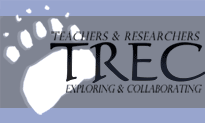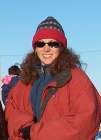 |
|
|
| Author |
Message |
Misty_Nikula-Ohlsen

Joined: 23 Mar 2004
Posts: 74
Location: Barrow, AK

|
 Posted:
Thu Jul 15, 2004 5:04 pm Posted:
Thu Jul 15, 2004 5:04 pm |
  |
Well over the past two days I have had quite an unexpected adventure. On Monday night at dinner, a biologist from the US Fish and Wildlife Department approached us and asked if we would be in town over the next 2 days or so. They needed people to help them with some bird banding. Kirstin had to get back to Barrow after “opening the portal” on Tuesday afternoon, but my schedule was more flexible and so I offered to help for a day or so. How could I pass up an opportunity to not only ride in a float plane but to also get bitten and pooped on by wild geese?

Me geared up for flying by N9798Z
Wildlife biologists band birds so that they can gather information about where the birds go on their migratory travels. When a bird dies or is shot by hunters, if it has a band on its leg, then the person can call a toll-free number to report it. All of the banded bird numbers are in a large database and the information about when and where the bird was found are recorded. This gives biologists information about how long birds live and where they go.
The next morning, at about 9 am, we set out. The Fish and Wildlife crew included Bill Larned, who was one of the pilots and the man who approached us the previous evening, Paul Anderson, the pilot of the plane that I was in, Heather Wilson, Dennis Marks and Julian Fischer. They had two amphibious float planes, which means that they could not only land on water, but also had wheels for landing on dry ground as well. We loaded up and headed out in a generally southwest direction from Atqasuk, looking for groups of white-front geese.

A map showing where we went
Riding in a small plane circling lakes in tight turns is much like riding a roller coaster all day. At least I felt like I had been at the amusement park riding non-stop by the end of the day. 

View from the plane
The geese can be captured during this time period because they are molting. When the geese molt, they lose all of their wing flight feathers and thus cannot fly away. Not all birds lose all of their flight feathers at the same time, many raptors lose only one or two at a time, so those birds never have a flightless period. Birds that molt completely like the white-front geese need a protected and safe area that has a lot of food available for their molting grounds. In the next week or so, they will finish regrowing their flight feathers and will leave this area and begin flying to their wintering grounds.

Goose feathers regrowing within their blood quills
In order to band the geese, we would find a large group, land in the lake that they were in and set up the nets and the “goose corral”, called the pot, on one end. Then they would herd the geese into the pot by water taxiing the planes.
We flew around for awhile doing reconnaissance on the lakes that were large enough for us to land and take off from. We needed to find a one that was both large enough and had a sufficient number of geese (150+) to justify the tine and effort of setting up the netting system and corralling them.
After about half and hour, we found a good sized lake with about 150 birds swimming around. We landed and set up the netting and the pot.

Our first group of geese
The goose trap works by having a round (roughly 10-12 foot in diameter) corral that has a small opening about 2-3 feet wide. On each side of the opening, there are lines of nets stretched out called “leads”. One lead is short and goes straight toward the water. The other is long about 500-750 feet or so and parallels the water about 20 feet from the shore until the very end where it just meets the water. The geese are herded toward the long lead so that when they come up out of the water, they run along it until they are forced into the pot. Then the net is pulled across the opening of the pot and the geese are trapped.

The long lead

The pot
The water was deep near the shore where we set up the nets and the rest of the group had hip waders. Since I only had my knee boots, I had to be fireman carried ashore. Not a graceful way to get ashore, I assure you, but I was dry. It took about 30 minutes to set up the trap and by the time we took off again to move around behind the geese and herd them in, they group had moved onto shore. Usually the biologists have a third plane that would watch the geese and keep them on the lake while the nets are being set up, but the third plane was stuck in Fairbanks overnight, however, due to poor visibility caused by forest fire smoke.
While we were trying to move our target bunch into the water again, we found a second group of geese in the neighboring lake. So our plane landed behind the second group and herded them across that lake and the short land bridge in between (200 yards or so) to the join with the first bunch in the original lake, where the corral was set up. The second group had a breeding pair and a brood of four chicks with them, but we let them swim off separately since the babies could not keep up and we didn’t want them in the nets anyway.

The brood heads off
The other plane, that Bill was flying, landed behind both groups in our net lake and began herding them through the lake.

Bill herding the geese toward the pot
We took off and when the geese were far enough from shore, landed behind them also and together herded the whole group toward the nets. Even with only two planes, it worked like a charm!

Closing the geese into the pen

Geese in the pot
Once the birds were in the pot, the banding station was set up on a tarp and small groups of about 20 geese were herded into a smaller part of the corral to be caught. Julian caught them by grabbing them and holding them by their wings behind their back and I shuttled them over 2 at a time to Heather, Bill and Paul, who were putting on the bands.

Setting up the banding station
The wildlife biologists did three things before releasing the birds, they determined its sex and its rough age, and put an aluminum band around its foot. They could tell the age very roughly by looking at the feathers on the bird’s breast. If it had very, very few or no black feathers then it was a second year bird (birds don’t molt in their first year after they are born). If it had a lot of black feathers then it was an “after second year” bird. The biologists couldn’t tell anymore than that as far as age. Dennis recorded the sex and age of each banded bird on a master list and then the bird was released back to the water.
When we got down to about 20 birds, I got to band a few. Sexing the birds was very difficult because I was afraid of hurting them. The biologists assured me that I was doing fine, though, and couldn’t really hurt them as long as I was careful. I was so slow that I only managed to do 3 in the time everyone else had done 5-6.

Me sexing the goose

Me putting on band

Me and my banded goose
All told, we banded 238 geese and of them we recaptured one goose that already had a band. Its existing band was recorded and it was released.
After we took down all of the nets, we had lunch amid multitudes of mosquitoes.
We were heading back to Atqasuk to fuel up the planes and maybe call it a day, when we saw a very large group of geese on a large lake. Bill landed to drop his passengers and keep the geese from heading to shore. We also landed to help set up the nets.
By the time we were about halfway through setting up the nets, Ed Mallek, the third pilot, arrived from Fairbanks.

Ed arrives!
He and Bill kept the geese in the water until the nets were ready. Then we all got into the planes and herded the group into the corral.

Herding geese with three planes
We ended up banding about 290 birds in that group and again had only one recapture. I got a bit faster at sexing and banding and did about 4-5 birds at the end. The biologists like to minimize the time that the birds spend in the pot because it is a very stressful situation for them.
Then we headed back in to Atqasuk and really did call it a day. We got back in about 7:30 pm and planned to group up and head out at about 8 the next morning.

Atqasuk from the air (yes, that is the WHOLE thing) |
|
|
     |
 |
|
|
|
View next topic
View previous topic
You cannot post new topics in this forum
You cannot reply to topics in this forum
You cannot edit your posts in this forum
You cannot delete your posts in this forum
You cannot vote in polls in this forum
You cannot attach files in this forum
You can download files in this forum
|
Powered by phpBB 2.0.11
© 2001, 2002 phpBB Group :: FI Theme ::
All times are GMT
| |
